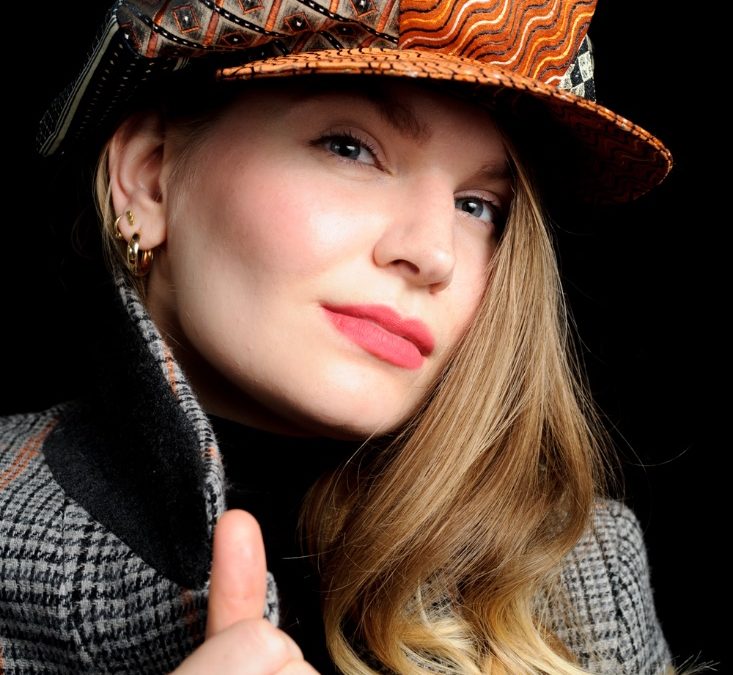
by Purba | Feb 10, 2022 | Shout out |
Mari Michel, an elegant sustainable brand, founded in 2020 by Mari Michelson has a unique story to tell the world. Guided by the sense of beauty embedded in natural materials and with a mindset aimed towards sustainability, this brand uses silk from second hand mens ties and turn them into Fair Hair Ties. Today Kazi Purba, the Founder of Fashionnovation, takes the pride to introduce you with one of the most unique brands that we have covered till now! Let’s hear from Mari Michelson’s journey towards sustianability with her brand.
Ms. Mari Michel, you have a very unique story. Please tell us something about yourself.
I was born in the 90s in a small country of a million people in Northern Europe, just a few years after the independence from the Soviet Union. The resources at the time, in Estonia, were scarce – priority was on importing the necessities. The clothes were very basic and there was not much of a choice. If you wanted something special, you had to make it yourself. That scarcity sparked creativity and showed an abundance of materials, which I took advantage of by upcycling them to one-of-a-kind garment pieces.
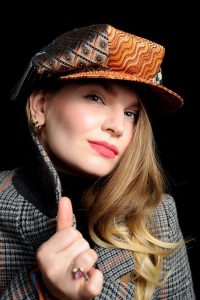
Mari Michelson with her OHOV cap made of silk collected from second hand men’s ties. Photo courtesy: Mari Michelson.
In our countryside house, we had a cabinet full of old Burda magazines from a grandmother, that I had never met. These were filled with silhouettes and colour combinations, that looked vintage and out of the ordinary. I would trace some of these silhouettes into my fashion folder and exaggerate the form and some of the features in order to play around and make my own designs out of it. It was through books and magazines that I discovered a lady, that perhaps, has influenced my understanding of fashion the most – Vivienne Westwood, of course. For me, I could relate to the rebelliousness, outrageous ideas, inventiveness, and diverging from the norm, that she so much represented.
At 16 and inspired, I moved to England alone to study Fashion Design. It was there, that I saw the mass production side of the business for the first time and became disillusioned about the sustainability factor in the garment business. I started feeling like it was not a place I wanted to contribute to. So I went on to leave fashion behind and enter a new career in business and software.
In 2020, things changed. With pandemic allowing more time to revaluate what I really want to do in this world, I made the decision, to really go for my dream – but this time, on my own terms. I decided not to become a fashion designer, where trends change with every season, but sustainable apparel and accessories designer, where quality matters and not quantity.
What is the story behind your brand?
Mari Michel was born at the end of 2020 in the Netherlands, but the ideas for it had been accumulating for a lifetime.
The first product grew out of an idea of using men’s silk ties as a material to create expressive hair accessories. These accessories are called Fair Hair Ties.
The metaphor for Fair Hair Ties comes from my own personal experience – I came out of the office where I worked as a software engineer, to follow my passion of designing sustainable apparel & accessories that give people a tool to express themselves.
The office environment is very standard, white and concrete, empty of expression – traditionally not a place one would feel free to show one’s true self. We have gradually been moving out of the cooperate style in the business environment, when I look around, I can rarely spot a man wearing a suit and tie for work. Our societal understanding has been changing a lot, especially in the past two pandemic years.
I find it very important, that no matter the environment, you should always be able to express yourself. For me that goes very deep into the core – to my scientific high school, I used to sport a Little Prince costume with a briefcase in hand, where Jimi Hendrix’s face was painted on.

Mari Michel’s signature accessories made of silk from ties. Photo courtesy: Mari Michelson.
Clothing & accessories is a great way of expressing yourself. Often even therapeutic, because what you put out can sometimes help you to gain confidence inside. Mari Michel is all about giving tools for self-expression! That’s why we even use the phrase ’Express Yourself’ as our slogan.
What motivated you to establish that?
I feel very strongly about already produced high-quality materials that are constantly being discarded in the world of consumerism, f.e. silk, fur, linen, leather. Natural materials that take a lot of resources to produce, but when produced, have a very short lifespan because the item they have been produced into goes out of fashion.
The first material that I chose for my current designs, is silk. I chose silk because I love it. There simply is no other material with comparable beauty & health benefits. I feel it is my mission to design tools for people to express themselves, that are not just aesthetically pleasing, but also sustainable and healthy.
What’s your product range?
At this point, we are focused on silk from men’s ties.
We make Fair Hair Ties, which are both hair accessories and bracelets in three different designs with unlimited colours and patterns, each one unique.
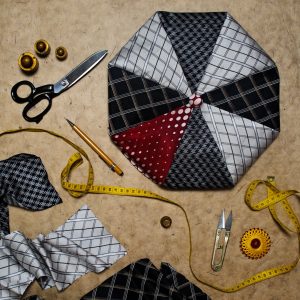
Mari Michel’s signature Ohov cap made of silk from ties. Photo courtesy: Mari Michelson.
Our most recent product is the Ohov cap – a hat made fully from silk fabric. Each cap is unique. The pattern and colour combination make each a true statement piece.

Mari Michel’s signature Ohov cap made of silk from ties. Photo courtesy: Mari Michelson.
The design of the Ohov cap is paying homage to the original baker boy cap. Baker boy cap origins go all the way to the 16th century, where Queen Elizabeth I of England sought to stimulate the Irish and English wool trade, by passing an act obliging males over six years of age (except for nobility and persons of degree) to wear caps of wool. This law further established the cap as a staple of Irish/English working-class clothing culture.
By making it from silk, which is a premium fabric, and making it a colourful unisex statement piece, we are contradicting the idea of its origins.
We also offer a style guidance service, where I help people to find their authentic style in one-on-one sessions.
What special do you offer to your customers through your brand?
All the materials that we use, have been transformed from one item to another, but the story stays, the feeling remains, the soul is still in the object.
These items have a sense of character.
Wearing it is special.
You really buy a piece that is just for you.
Every customer is special, and they get their special item.
And I never make anything that is standard. I am always looking for something new, a twist on things. I look for inspiration for the future from the past. Having something old, that has been stitched into the fabric of our culture, is something we have relied on, it is comfortable and gives a certain emotion to people. What I like to do, is to take a part of it and transform it into a new concept.
Does your brand care about environment and sustainability? How are you promoting sustainability with your works?
Before I went to study fashion, I never questioned myself about making sustainable choices. I was lucky to be brought up in a family that had a reasonably sustainable lifestyle and in a culture, where feeling being part of nature was immensely integrated into society. I thought that everybody takes care of nature as it would be of their own family member. When I went abroad for the first time and got to have a closer observation of the global fashion industry, I saw that sustainability in fashion is far from ‘of course’. The leverage was on profit.
I think profit should never be leading to anything we do as people.
The real energy behind projects comes from mission and passion.

Mari Michel’s signature accessory made of silk from ties. Photo courtesy: Mari Michelson.
Our mission at Mari Michel is to make expressive accessories and apparel with sustainability as an underlying value in everything we do. We re-use high-quality natural materials, that have a long lifespan. Every item we produce is unique, which is one of the most sustainable ways of production. There is no surplus of materials or products that go to waste. Our production is based in Europe, we offer our products at fair prices and hold transparency as a key value in communication.
What are your future plans with your brand?
Expanding on our current concept and adding more products from sustainable silk. Even more so, we want to move onto new materials – there are a lot of other discarded materials, that we have been developing ideas about.
We are curious about modern materials that are fully compostable and are open to collaborations in this area.
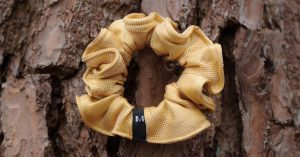
Mari Michel’s signature accessory made of silk from ties. Photo courtesy: Mari Michelson.
The next phase is going from accessories to apparel collections.
It is important for us to interact with the community, which is why are making stories that are relevant in today’s fashion industry and will be continuously giving out new topics to discuss with a humorous undertone.
The goal is to keep creative juices flowing and not to be overly fixated on predicting the future, rather let our values and passion drive us.
You can read more about how Mari Michel addresses sustainability here:
https://marimichel.nl/pages/sustainability-1
You can read more about silk properties here:
https://marimichel.nl/pages/silk-properties
You can read about our style guidance service here:
https://marimichel.nl/pages/style-guidance
Website: marimichel.com
Instagram: http://instagram.com/bymarimichel
Facebook: https://www.facebook.com/bymarimichel
LinkedIn: https://www.linkedin.com/company/marimichel
You can also read this premium article on the 21st century fashion!
Lili: A Sustainable Brand for Upcycled Jewelry
If you want to know about M&L Creative, the Number One Choice for Sustainable Brands, you can read it here!
If you want to read about another wonderful woman named Rebecca who’s working for her fashion brand RebeccaRowe.ca to make women feel confident, in this link.
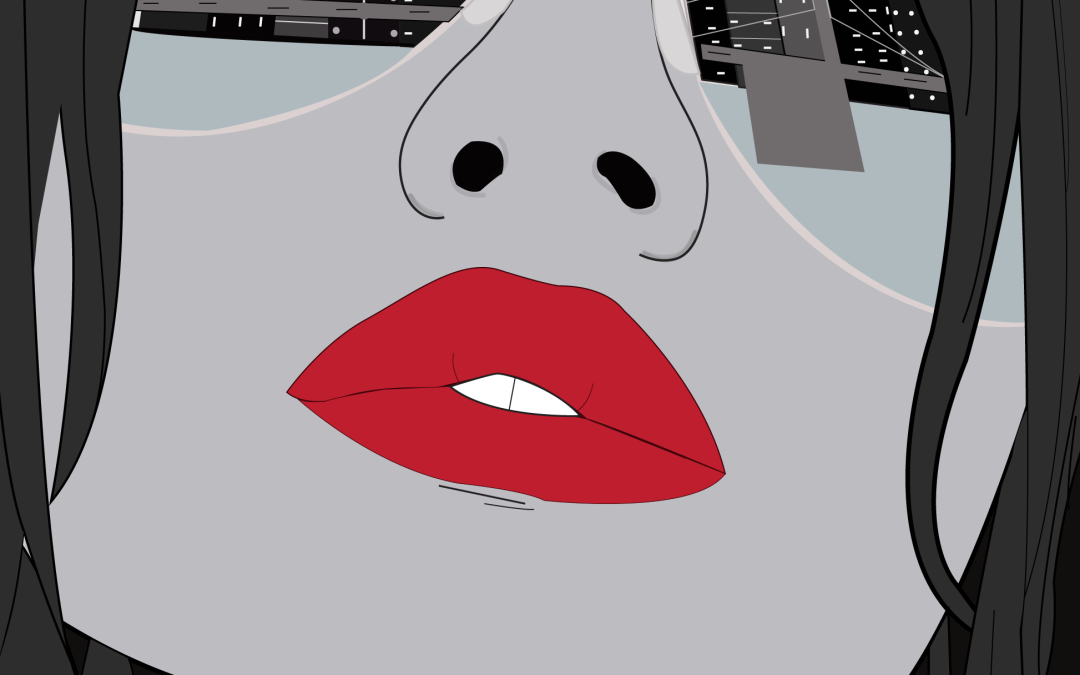
by Purba | Nov 23, 2021 | Fashion Illustration, Our works |
Fashion illustration is a great tool for fashion designers to express their ideas to their potential customers. As a picture can speak a thousand words, fashion illustration lets a designer to communicate easily. Fashion illustration is taught in every fashion institutions and Department of Textile Fashion and Design of Bangladesh University of Textiles is not an exception. Here are some of the stunning fashion illustrations from different batches of the students and members of Fashionnovation.
1. Fashion Illustration with print repeat designs by Sumaiya Ferdousi Arpa
Sumaiya Ferdousi Arpa’s striking illustrations with seamless print repeat designs are striking. The floral designs with vibrant colors are an expression of femininity.
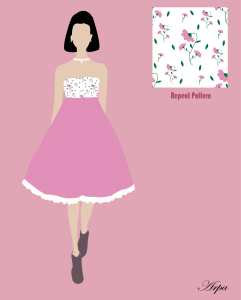
Fashion illustration by Sumaiya Ferdousi Arpa. Fashionnovation
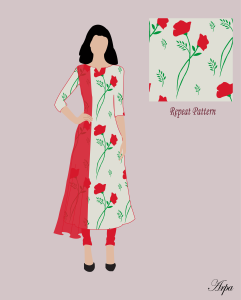
Fashion illustration by Sumaiya Ferdousi Arpa. Fashionnovation

Fashion illustration by Sumaiya Ferdousi Arpa. Fashionnovation
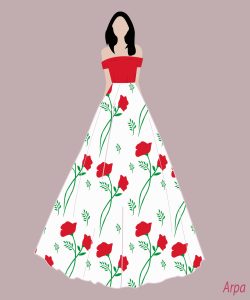
Fashion illustration by Sumaiya Ferdousi Arpa. Fashionnovation
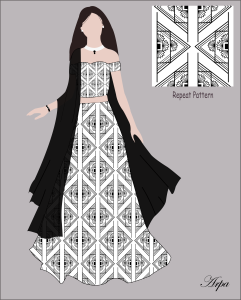
Fashion illustration by Sumaiya Ferdousi Arpa. Fashionnovation

Fashion illustration by Sumaiya Ferdousi Arpa. Fashionnovation
2. Fashion illustration of Bangladeshi couple by Gulshan Ara Tasnim
Gulshan Ara Tasnim has done some amazing tasks with the dress design of Bangladeshi couple where she has designed saree and punjabi. The vibrant color and the details are noteworthy. She has also produced an anime type character which represents her Otaku feelings.
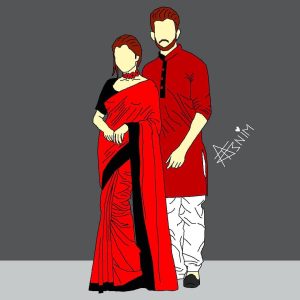
Fashion illustration by Gulshan Ara Tasnim. Fashionnovation
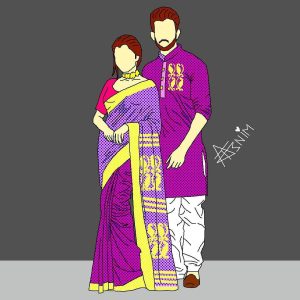
Fashion illustration by Gulshan Ara Tasnim. Fashionnovation
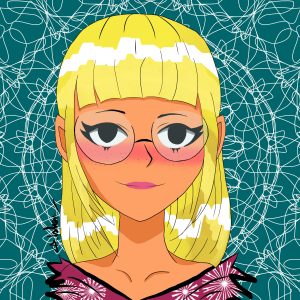
Fashion illustration by Gulshan Ara Tasnim. Fashionnovation
3. Western Dresses by Jinnat Ara Ferdous
Jinnat ara ferdous has experimented with western dresses and her striking detail works are visible which shows her expertise of focusing on the details. She has done some intricate patterns on her dresses and worked with darker colors. All in all her details her praiseworthy and as a student these works are certainly a sign of excellence!
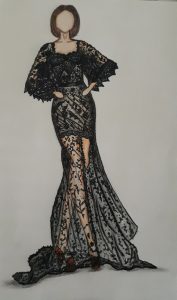
Illustration by Jinnat Ara Ferdous. Fashionnovation
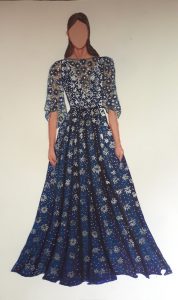
Illustration by Jinnat Ara Ferdous. Fashionnovation
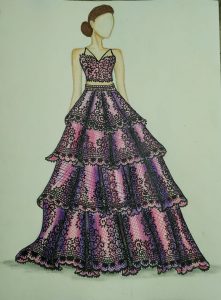
Illustration by Jinnat Ara Ferdous. Fashionnovation
That’s all for today! Fashionnovation will showcase more of such amazing works in the future. Till then stay tuned and don’t forget to send your works like these to our email address: fashionnovationfd@gmail.com
Take care!
As you have read and seen these amazing works of fashion illustration, you might be interested to learn how they are done! Don’t worry! We got you covered here!
You can also read this premium article on the 21st century fashion!
And if you want to read one of our premium case studies on Fast Fashion Vs Slow Fashion, you can go here!
Fast Fashion Vs Slow Fashion: A Case Study
You can also see some more wonderful works of students below:
12 Basic Fashion Studies Sketches Done by Students That Will Inspire You In Your Next Fashion Study Lab Work
To be more creative like these fashion illustrators or to know the relationship between creativity and fashion, you can read this article named Creativity and Fashion Design!
To see how creative our members are, you should read another of our article where they have drawn some basic fashion sketches which will blow your mind!
Our Fashionnovation members don’t only draw sketches, they also create many creative and complex draping. To check that out, you can check our Fashion draping, variation of cascade article!
If you want to partner with us, collaborate, write articles or simply want to contact, feel free to email us at: fashionnovationfd@gmail.com
We always check your emails!

by Purba | Oct 28, 2021 | Fashionnovation events |
On September 26, 2021, Fashionnovation arranged a session with Ms. Umme Hani Barsha, an ex-student of BUTEX batch-38 and also Adjunct faculty of Department of Textile Fashion & Design (TFD) of Bangladesh University of Textiles (BUTEX) who is currently studying MS in Consumer & Design Science, majoring in Design and Applied Arts at Auburn University. She is our first guest in “Fashionnovation Your Mentor Talks.” She is one of the dearest mentor and well-wisher of Fashionnovation and she supported the platform from the beginning of its journey, right from 7 July 2018.
In that session, our discussion areas were higher studies in fashion, building up and honing skills related to fashion and how to enjoy life to the fullest-valuing each and every experience we gather. In the session, BUTEX 43, 44, 45 & 46th batch joined spontaneously and all credits of managing & directing the session goes to the Founder & President Kazi Farhan Hossain Purba.
Our guest- Ms. Barsha started the session by stating the most valuable advices of her Professor which are- Always ask questions! Because in graduation life, whoever is curious to know more, he/she will be more successful in his/her life.
Fashion design higher study guidelines:
Ms. Barsha then guided us about higher studies. If a student wants to pursue his higher education in Europe, then the student must have an excellent portfolio. European Universities demand more practical knowledge in the design sector that can be shown through portfolios. Students who are interested in studying in the U.S.A, mostly need to take GRE. In many institutions, they demand good verbal scores on GRE. A few institutions waived GRE recently also. In the USA, very few universities offer textile engineering degrees directly. One of them is North Carolina State University. Students may look at other departments like dept. of Material Science (students from the dept of Fabric & Yarn engineering), dept. of Chemical engineering (students from the dept of Wet Process Engineers & Dyes and Chemical engineering), dept. of Industrial engineering. Most of the institutions offer graduate degrees in Apparel Merchandising and Apparel Designing or Fashion Designing under the department of Consumer and Design Sciences or Agriculture.
Then if you want to go to Germany, fashion design students may face some challenges. Usually, there are no tuition fees for most of the courses but in fashion design as well as other art-based subjects such as architecture, and photography, students are required to pay tuition fees. Few colleges have no tuition fees but they teach in the German language instead of English. This is the scenario for many other European universities like Italy, France, and the Netherlands. If they know their language, then they can apply for Dutch and French scholarships respectively. Italy, Netherlands, New Zealand, and Denmark also have textile-related universities as well as they offer graduate degrees in fashion. ArtEZ from the Netherlands offers a master’s in fashion in English, and they have scholarships. In New Zealand, you can get a government scholarship in the design sector from Auckland University. For applying in Denmark, one must complete the first level of their language. In Japan, there is a great fashion design school named Bunka Fashion College which ranks in the top 20 in the world. In Hong Kong Polytechnic, there are mainly PAD courses but you can also go through your graduate level here.
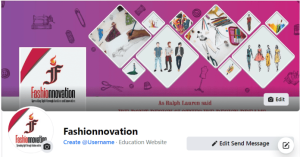
Then if you want to go with Australia or Canada, it will be suitable if you can go on a fully funded scholarship. Pertinently, it must be included that there is only one university in Canada named Ryerson that offers a graduate degree in fashion design. The University of Toronto, the University of Manitoba, and the University of Alberta offer textile-related subjects like material science and other degrees. In Australia, RMIT offers a graduate degree in fashion design as well as textile engineering. There is a scholarship for women but that requires two years of working experience.
You will be happy to know that there was a special guest in our session whose name is Mr. Asef Amer Priyo who is also our BUTEXian senior from the same batch of Ms. Barsha. And he is now working in Decathlon Sports Bangadesh, having working experience of 4.5 years in the industry. He advised to enrich English communication skill, presentation skill and learn Microsoft Excel & Powerpoint from undergraduate level. He clarified about the job sectors of Textile Fashion Design as well as Textile Engineering. He said actually one will get a job or not it totally depends on the performance at the interview board and how much your CV is enriched. Also you must have a very strong portfolio. And at the interview board, you must know what you say and know what you know.
Then again Ms. Barsha said a fashion designer must have knowledge about the fabric, its drapability, texture, etc besides art and design. Because fabric, stitches, pattern-these all are strongly connected with fashion.
When one of the participants of that session asked about the importance of CGPA in higher studies, Ms. Barsha replied that a high CGPA is not a must for applying for foreign scholarships. But if you want a fully funded scholarship and a good subject as per your choice then you will be much benefited if you have a high CGPA. But don’t be upset if it’s by chance low because you can cover it up with other facts like having a great portfolio as well as achieving high scores in speaking & writing on IELTS and GRE scores.

Mr. Asef Amer Priyo was sharing his vauable experience with the audience.
Is having a published research paper important for higher studies?
Another question came from the participants about the importance of research papers. Madam replied that actually on the master’s level, teachers of foreign universities do not really expect research papers from the students. Students may have a review paper which is helpful also. But one should have a clear knowledge of their research interests. She again mentioned having a strong portfolio always helps. She referred to a YouTube channel named Zoe Hong to enrich your portfolio. She also suggested a site named issuu.com see many kinds of portfolios there.
Ms. Barsha said that during her application for MS, she categorized the ranking of the university where she applied and research interests and if the university provides funds or not. Again another student asked her about what can the student do with fashion degrees. Madam replied there are fashion photography, visual merchandising, fashion merchandising, sourcing sector & designing sectors. Last, of all, she stressed upon especially for fashion design students to learn Adobe software like Adobe Photoshop, Adobe Illustrator, etc.
At last our special guest Mr. Asef gave us some life hacks. He said,”Forget about being disheartened. No knowledge is small, no knowledge is short! So if you have leisure, it’s better to learn something new. Always use your time efficiently.” Then Barsha madam suggested, “Obviously do work but enjoy your life to the fullest in your undergrad!”
It was really an amazing session! We learnt a lot from Ms. Barsha & Mr. Asef. We are expressing our gratitude to them and the organizer of this session, Mr. Kazi Farhan Hossain Purba. Hope that we will get more sessions like this & will be able to learn a lot!
Nashita Ahmed
Dept.Environmental Science & Engineering,
Bangladesh University of Textiles (BUTEX)
ID: 2020-1-10-041
You can also read our article about Auburn University’s AMDA, their activities and goals!
Auburn University’s AMDA, Their Activities & Goals
You might also be interested to read about National Institute of Fashion Technology (NIFT), Hyderabad, A Heaven for The Fashion Learners
![Textile in Space: Flying Up to Reach the Stars (Chapter 2)]()
by Purba | Jun 29, 2021 | Academic |
Textile in space is a dream that human beings have seen beyond the use of textiles in mere clothings as a covering.
As we continue our journey to reach the stars following with the previous chapter of Textile in Space, we will surely come to know some of the amazing applications of textile in both space and aerospace. We have already come to know some of the key features for space textiles (such as fiber, yarn, fabric) which are essential to be converted into intricate and highly modern aero-crafts.
Nonetheless, a good strength to weight ratio, high abrasion resistance, extremely light-weight, flexibility, durability, comfortability, mechanical and chemical resistance are some of the compulsory features of textiles in this regard. And keeping this in mind, the developed technical textiles are serving in this textile space field with no sweat!
Textile in space: In Aircraft Manufacturing- When Dream Becomes Reality to Reach the Space!
Textiles have been used by human beings since the pre-historic time. Only the recent researches for the past few decades have led to the concept of developing technical textiles in space. One of the major fields of applications of textile is in the process of aircraft manufacturing and related products. Surely, getting to know some of the applications will give us a glimpse on how our dream to reach the stars in becoming a reality!
The broken parts of rotor blade can operate as projectile and form external effect. So, woven structure and material such as Kevlar, Nylon, glass fiber metal resign, aromatic polyamide and carbon/epoxy composite structures are used to decrease the impact damage. These textile materials co-operate with flight surface and help the rotor inner side for covering against ballistic damage.
-
Aircraft Interior Design, another example of textile in space:
Inside the aircraft and spacecraft- from furnishing textiles to wall covering, floor carpet, seat & seat belts, curtains and other interior designs are formed from textile composites. In the automotive sector as well as aircraft, spacecraft and onboard ships, drive belts are now used in the engine. In the past, they were primarily made of rubber or flexible plastic. Now coated with textiles or textile mixtures have established durability, comfortability, safety in many applications. They must determine qualities that affect in everyday use to clean easily, to be fire –resistant and free of pollutants that could vaporize and pollute the air. Modern textile materials like microfibers, nanotechnology and new plastics have remodel the use of textiles in interiors.

The Interior of a spacecraft for which technical textile materials are one of the the primary elements to manufacture. Courtesy: Unspash.
Parachutes are necessary for the protection for the pilots, aviators and passengers of the aircraft. Raw materials used in the parachutes are high performance fibers such as Nylon, Polyester, Kevlar, Nomex and so on. More specifically, parachutes are made up of high tenacity fire resistant material called ‘Rip-stop Nylon 6.6 fabric’ with tough and durable coatings for heat and air retention. Some other important characteristics for these materials to obtain are UV protection, heat and abrasion resistant, water proofness, high specific strength and light weight.

Parachute systems for space and military, an example of textile in space. Courtesy: Aerospace America.
A space suit, mostly worn by astronauts, is a pressurized garment which is useful during space flights. This suit performs as the ultimate protective clothing that protects the astronauts from damaging conditions in the space where a single sand can be dangerous for its extreme speed. It is also known as Extra Vehicular Mobility unit (EMU).
From feet to head, spacesuit consists of many parts which performs various tasks like containing tubes that supply oxygen, protecting from high pressure and dust in space, containing electric conductors etc. Under the suit, astronauts wear another piece of clothing named liquid cooling and ventilation garment that interlinks with the tubes. Water flows through the tubes to keep astronaut cool. Since, containing oxygen is a must in order to survive in space, a good oxygen chamber is required. Hence, on the back of the space suit, there is a backpack made from technical textiles that holds oxygen and removes carbon dioxide to make easy breathing system for astronauts. It also supplies electricity for the suit. According to the required functional purpose, materials like Dacron, Neoprene, Kevlar, Spandex etc. are used to make spacesuit.

Man Wearing Space Suit, taking textile in space. Courtesy: Pixabay.
G-Suit is a special flight suit worn by aviators, astronauts or fighter pilot in aircraft who are commanded to go against high levels of acceleration force or gravitational force(g). Also, owing to the name as Anti-Gravity Suit, this item is designed to avoid a black-out and g-Loc (g-induced loss of consciousness) generated by the blood pooling in the lower part of the body when under acceleration. This suit is, therefore, necessary as black-out and g-Loc have caused a number of disastrous aircraft accidents previously.

A dummy wearing an Anti-g Suit trousers and cummerbund fitted over a flying suit. Source: Wikipedia.
G-suits consists of artificial inflatable bladders, having air or liquid that can be pressurized using a g-sensitive valve. This also has controlled firm to legs and abdomen under high values of g.
Future Development of Textile in Space Products-What is Coming Next?
Every kilogram that needs to be launched in a spacecraft is so important that it increases both fuel utilization and costs! Lightweight, high strength, cost efficiency, ease of working with the materials and safety are all parameters that should be achieved in developing textiles. Innovations like incorporating bionics into the development of new textiles can open entirely new solutions for engineers and scientists.

A spacecraft during its launch and ready to reach the stars! Photo Taken at the Kennedy Space Center, USA. Courtesy: Unsplash.
In 2015, NASA revealed to try to get humans living on Mars by 2030. If these plans are to be performed successfully, then it’s a consideration that textile materials can be made not only from a clothing and safety perspective, but also can be used structurally to understand the optimal living conditions. Nonetheless, the designers have to work days and nights to figure out the best possible anatomy of a spacesuit! As the weather in Mars is extremely unfavorable, no specimens have yet returned to Earth from Mars which is still the biggest challenge in making space suits. For this regard, NASA is preparing the Futuristic Z-2 space suit of Z-2 prototype for the next generation!
As we come to an end to our space journey, we certainly realize textile is not just used only for daily uses or enhancing beauty but also for protecting from hazardous environments in air, outer-space, Mars or any other outer planet. This field of application is nothing but innovative and cool! Thus, textile especially, technical textiles enabled us to conquer any innovative plan about space and decrease mortal accidents caused by dangerous space area and also allow us to definitely fulfill our dream to reach the stars!
By Team Bespoke:
Mentor: Tasphia Zaman (TFD 44, ID: 2018-1-6-009)
Leader: Khadiza Sharmin (TFD 45, ID: 2019-1-6-015)
Executive: Nahema Haque Khushe (TFD 46, ID: 2020-1-6-002)
References:
Image 1: https://unsplash.com/photos/n463SoeSiVY
Image 2: https://unsplash.com/@nasa
Image 3: https://unsplash.com/photos/NCvvr837fz8
As you seem to be both tech savvy and fashionista, you will enjoy our premium article on Textile in space: Flying up to reach the stars!
To know the biggest fashion trends of 21st century, you can visit here! Moreover, if you want to know the future of fashion industry after Covid-19, you can click here!
And if you want to read one of our premium case studies on Fast Fashion Vs Slow Fashion, you can go here!
Fast Fashion Vs Slow Fashion: A Case Study
You can also read our interesting and well researched article on: Architecture Fabric: The New Use of Textiles as A Building Material
![Textile in Space: Flying Up to Reach the Stars (Chapter 2)]()
by Purba | May 20, 2021 | Academic |
Fast fashion vs slow fashion is like yin and yang in the arena of fashion world. Though the terms are completely opposite, there is a need of sensing their difference and concretely know which means what- fast fashion vs slow fashion-what are the differences, fast fashion and slow fashion brands, which fashion to choose when, etc.
What comes to your mind when someone says fast fashion vs. slow fashion?
On the surface, fast and slow fashion seem pretty straightforward, but in reality, they can both be complex within the realm of sustainable fashion. Today we will cater you a case study on fast fashion vs slow fashion where you will find the differences and a comparative study to ponder on.
[Attention! Read the full article. There is a fun quiz to check your knowledge about fast fashion vs slow fashion]

According to Google Trends, the highest interest in this topic was in April 2009 and the second highest interest is on October 2021.
What is fast fashion?
Fast Fashion is the process of imitating trends and styles from the big-name designers on the runway which is most of the time lower quality, cheap priced and not handmade. Manufacturers mass-produce the garments at lightning speed to beat the competition and keep up with customer expectations. Since the Clothing is produced quickly and cheaply, hence we term it as fast fashion.

Fast fashion examples:
H&M, Zara, etc. retailing brands’ mass produced t-shirts, pants, etc.
Fast fashion vs Slow fashion brands:
Fast fashion and slow fashion brands also have differences according to their design, production, selling and operating criteria which enable us to do Fast fashion vs slow fashion brands comparison.
A list of fast fashion brands:

Interest in the ‘Fast fashion’ topic according to Google Trends. Source: Screenshot taken from Google Trends.
What is Slow Fashion?
Slow fashion is about conscious shopping and wearing clothing with sustainability in mind. It is about designing, creating, and buying clothing that last a long time. Here quality matters over quantity and since the process takes place slowly, we term it as slow fashion.
`

Dhakai Muslin, an example of slow fashion
Slow fashion examples:
Handmade classical products like Jamdani, Dhakai Muslin, Nakshi kantha, etc. Moreover vintage and second hand clothes are also a part of slow fashion.
Slow fashion history:
The term ‘slow fashion’ is not so old. In fact, this term emerged in the year 2007 when journalist Kate Fletcher, a fashion and sustainability pioneer, coined the word “slow fashion” in an article published in the British publication-The Ecologist.
`

The photo of Kate Fletcher who coined the term ‘slow fashion’. Her name is now attached with the history of slow fashion.
Actually, the concept of slow fashion is inspired from the Slow Food Movement founded by Carlo Petrini in Italy in 1986 which links pleasure and food with awareness and responsibility.
After her coining out this term, it became a world trend and talk of the fashion world.
Is slow fashion more sustainable than fast fashion?
Slow fashion promotes a slower, steady and more sustainable approach as it is hand-made with sustainable raw materials like lotus, banana, orange fiber and promotes the use of vintage or second hand clothes, upcycling old clothing materials. It decreases carbon footprint and takes care of the 3Ps of sustainability- People, planet and profit.
Comparing the benefits of slow fashion and fast fashion
- Slow fashion reduces the consumption of resources and the amount of wasteland people can wear for a long time because they are made up of durable materials but is not cost efficient.
- Fast fashion quickly responds to rapidly-changing fashion trends and consumer tastes.It carries high-end designs to the masses at affordable price ranges.

Fast fashion vs slow fashion Google Trends. The interest and talk of fast fashion was always more than slow fashion from the beginning. Source: Google Trends.
Let’s compare the problems faced
- In Slow fashion small quantities are produced at low speed and hence are not able to compete with the economy of scale strategy. And generally, the products are more expensive than the commodities.
- Due to the greater manufacturing speed, the factories are likely to neglect the working conditions. The low quality and low pricing of the products results in the increase of fashion waste
Comparing the production schedules
Slow fashion has 2-3 cycles per annum whereas fast fashion has approx. 50+ cycles per annum. We can clearly see the production scale of fast fashion is near 25 times of the slow fashion !!!
Comparing the fashion sales
We can see the graph of slow fashion is very low at the beginning, but gradually the graph of slow fashion can be seen increasing, which means slowly people are understanding the importance of slow fashion. Though the graph of fast fashion is increasing rapidly because people always prefer cheaper prices over quality clothing.

Fast fashion vs slow fashion in India (USD Million).
|
Fast Fashion |
Slow Fashion |
| Production |
Rapid and mass production |
Slow and deliberate production |
| Design Approach |
Trend-driven and short-lived designs |
Timeless and enduring designs |
| Manufacturing |
Outsourcing to low-cost labor countries |
Emphasis on local, ethical manufacturing |
| Material Selection |
Synthetic materials and low-cost fabrics |
Natural, organic, and sustainable materials |
| Environmental Impact |
High pollution and waste generation |
Focus on sustainability and eco-friendliness |
| Consumer Behavior |
Impulse buying and frequent purchases |
Conscious consumption and fewer purchases |
| Supply Chain |
Lack of transparency and unethical practices |
Ethical sourcing and transparent supply chain |
| Social Responsibility |
Exploitation of low-wage workers |
Fair wages and labor rights |
| Longevity |
Disposable fashion with short lifespan |
Durable garments designed for longevity |
A table showing the differences between fast fashion and slow fashion.
Conclusion
After looking at the facts & surveys we can say that:
- Fast fashion creates a lot of wastage and hence is quite harmful to the environment hence slow fashion should be promoted more in order to maintain sustainability
- But when looking at the prices fast fashion is more preferable due to it’s cheaper prices.
But in the end, it depends on what the customer wants and what he prefers. It has to be either quality products/cheaper prices.
Nandini Kapu
Student at NIFT- National Institute of Fashion Technology
(NB. This article was written by Nandini Kapu. It has been updated and will be updated by Fashionnovation whenever we find new relevant information to make it rich so that the information best serves you. So, stay with Fashionnovation!)
You can also read another of our premium article on Fashion in the 21st century here!
Fashion in the 21st Century
Related articles:
Bimbo Fashion
If you want to know the most influential US fashion Brands and Germany Fashion Brands, you can click accordingly!
Feel free to write to us at fashionnovationfd@gmail.com
We accept guest posts!























